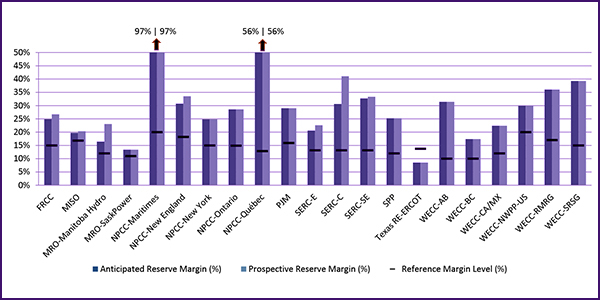By Rich Heidorn Jr.
ORLANDO, Fla. — Most regions have sufficient resources to meet anticipated loads this summer, but Texas and California are at risk from potential natural gas shortages and wildfires, NERC reported Tuesday in its 2019 Summer Reliability Assessment.
The report, which covers June through September, noted ERCOT’s warning it may have to issue energy emergency alerts to respond to resource shortfalls as its summer reserve margin has fallen to 8.5%. (See ERCOT: More Capacity, but Emergency Ops Still Expected.)
Meanwhile, natural gas supply from interstate pipelines will be insufficient to power electric generation on summer peak load days in Southern California, requiring withdrawals from the Aliso Canyon storage facility. NERC also cited concerns over Southern California’s ramping capacity and transmission line shutdowns during wildfires.
ERCOT
ERCOT’s reserve margin dropped from 10.9% a year ago, the result of continued demand growth, delays in planned generation and the mothballing of the 470-MW Gibbons Creek coal-fired generator.
Although its 2018 reserve margin was below its reference margin of 13.75%, ERCOT survived without calling emergency alerts thanks to “high levels of generator availability, response to market signals and unit performance,” NERC said.
ERCOT’s operating plans include voluntary load reductions and power imports if needed.
ERCOT’s summer Seasonal Assessment of Resource Adequacy (SARA), released last month, said the grid operator may tap load resources that can provide operating reserves, use contracted emergency response resources and instruct utilities to employ load management and distribution voltage reductions. It may also import emergency power across its DC ties and ask switchable generators serving ERCOT neighbors to prioritize it instead.
Ramping Concerns
In CAISO, NERC warns of shortages in resources with upward ramping capability, which it said could mean the need for imports to maintain system frequency and prevent load loss in late afternoons as solar generation output drops while loads remain high. “Should extreme temperatures extend over a large area to the point where neighbors lack surplus energy, load could be at risk from a shortage in ramping capability,” NERC said.
NERC said gas-fired generators in Southern California will need to tap fuel from storage because interstate pipelines may not be sufficient to meet peak loads. As a result, withdrawals from the Aliso Canyon natural gas storage facility would be necessary to ensure adequate fuel for generators in the area.
Restrictions on Aliso Canyon “remain an item of focus,” NERC said. High storage withdrawals during winter 2018/19 has meant below-average storage levels this summer.
“The Southern California Gas Company (SoCalGas) forecasts that it will be able to meet the forecasted peak day demand under a ‘best-case’ supply assumption even without supply from Aliso Canyon,” the report said. “However, under a worst-case supply assumption, supply from Aliso Canyon will be necessary to meet that forecasted peak day demand. Should operating restrictions result in natural gas supply curtailments that affect electric generation in the Southern California area, mitigation procedures that have been in place since 2016 can be used to maintain BPS reliability.”
Wildfires
NERC is also citing government warnings of an elevated risk of wildfires in the Western U.S. and Canada, noting utilities’ plans include shutting down transmission lines.
The April-June outlook from the National Interagency Fire Center, Natural Resources Canada and National Meteorological Service in Mexico predicted above-normal wildfire potential for California, the Pacific Northwest (Western Oregon and Washington), Western Alberta, British Columbia and Northern Mexico, NERC said.
In addition to preemptively de-energizing transmission lines in high-risk areas, utilities are using “enhanced vegetation management, equipment inspections, system hardening and added situational awareness measures,” NERC said.
Nevertheless, NERC said the risk of resource shortfalls in CAISO is lower this year than last summer, citing well above normal reservoir levels and mountain snowpack for “greatly reducing the potential for operating reserve shortfalls.” (See CAISO Predicts Plentiful Hydro, Gas Constraints.)
If CAISO activates its emergency operating plan — for example, in response to the inability to meet spinning reserve requirements — it will employ a number of mitigation measures to minimize loss of load, NERC said including the following:
- The Flex Alert program, which can reduce peak loads
- The Restricted Maintenance program to reduce forced outages
- The performance of manual post day-ahead unit commitment and exceptional dispatch of resources under contract to serve load and meet ramping requirements
- The performance of manual exceptional dispatch of intertie resources with resource adequacy obligations to serve CAISO load
- The use of demand response programs, including the Reliability Demand Response Resources (RDRR) under the “Warning” stage
- The performance of manual exceptional dispatch of physically available resources not under capacity contract





